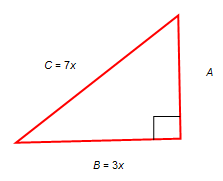How do you use the Pythagorean Theorem to find the missing side of the right triangle with the given measures given c is the hypotenuse and we have b=3x,c=7x?
2 Answers
Explanation:
The Pythagorean Theorem states that
#a^2+b^2=c^2#
in a triangle with legs
With
#a^2+(3x)^2=(7x)^2#
Now, recall that when we have something like
#(3x)^2=3^2*x^2=9x^2#
Similarly, for
#(7x)^2=7^2*x^2=49x^2#
Substituting these back in to the Pythagorean Theorem equation, we see that
#a^2+9x^2=49x^2#
Subtract
#a^2=40x^2#
Take the square root of both sides.
#a=sqrt(40x^2)#
We can rewrite
#a=sqrt4*sqrt(x^2)*sqrt10#
#a=2xsqrt10#
Explanation:

Using the principle of proportionality disregard the
Think if it as working on a triangle that has been reduced in scale but is of the same ratio.
By Pythagoras
So
'~~~~~~~~~~~~~~~~~~~~~~~~~~~~~~~~~~~~~~~~
Technically we could write
It is simpler just to leave it out for now but incorporate it at the end.
'~~~~~~~~~~~~~~~~~~~~~~~~~~~~~~~~~~~~~~~~~~~
Scaling back up we have


